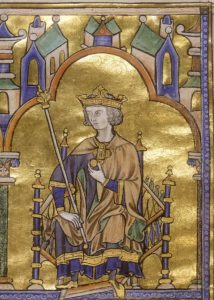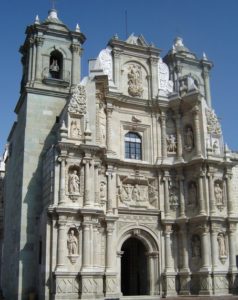Podcast: Play in new window | Download
Subscribe: Apple Podcasts | RSS
 The Aztecs called this southern region of Mexico Huāxyacac named after a certain type of tree that grew in the area. Today Oaxaca is one of the most biologically and culturally diverse states in all of Mexico. Its mountains, jungles and beaches fall mostly in the tropical and subtropical zones with more temperate climates increasing in frequency with altitude. Oaxaca’s rugged terrain is responsible for keeping many indigenous cultures intact and today the state is home to 16 distinct native groups. The Spanish arrived here in the years immediately after the fall of the Aztec Empire prompted by stories of gold and wanting to establish a Pacific port to engage in trade with Asia. The great variety of peoples and the long history of this area have caused this state to be the origin of many interesting legends. Here are 5 brief ones.
The Aztecs called this southern region of Mexico Huāxyacac named after a certain type of tree that grew in the area. Today Oaxaca is one of the most biologically and culturally diverse states in all of Mexico. Its mountains, jungles and beaches fall mostly in the tropical and subtropical zones with more temperate climates increasing in frequency with altitude. Oaxaca’s rugged terrain is responsible for keeping many indigenous cultures intact and today the state is home to 16 distinct native groups. The Spanish arrived here in the years immediately after the fall of the Aztec Empire prompted by stories of gold and wanting to establish a Pacific port to engage in trade with Asia. The great variety of peoples and the long history of this area have caused this state to be the origin of many interesting legends. Here are 5 brief ones.
Number One: The Legend of the Decapitated Princess
The modern-day seal of the City of Oaxaca has at its center, the severed head of a young woman. While this may seem strange to have a disembodied head as a symbol of a respectable municipality, the legend behind this is still being told to this day.
At around the time of the Spanish conquest, King Cosijoeza and Queen Coloyocaltzin ruled over the Zapotec kingdom located in modern-day Oaxaca. The king and queen had a son named Cosijopi whom they sent to rule over a minor province in the Isthmus of Tehuantepec. Prince Cosijopi had a daughter, the Princess Donají who was either a young woman or older teenager at the time of their transfer to the Zapotec administrative capital of the region, a city called Zaachila. Not soon after the arrival of the prince and his daughter the Mixtecs attacked the city of Zaachila and captured  Princess Donají to hold her hostage. When the Zapotecs attacked the Mixtec city of Monte Albán, the Mixtecs fled and beheaded the Zapotec princess. When the Mixtecs were captured by the Zapotecs they confessed to where they buried the body of Princess Donají but kept secret the location of her head. About 10 years after this incident, with the Spanish in full control over the area known today as the state of Oaxaca, a shepherd was tending to his animals in a field now located in San Agustín de las Juntas, near the international airport of the modern city of Oaxaca. The shepherd came across a beautiful wild iris and instead of cutting it, he decided to uproot it. When he pulled the bulb out of the ground he first noticed a human ear with gold earrings in it and then he brushed away more dirt to reveal the perfectly intact and completely unmarred head of the Zapotec princess Donají. With great care the shepherd gathered up the head to take it to the authorities in Oaxaca City. Both the head and body of the princess were reunited and entombed at the Church at Cuilapan. Before the funerary ceremonies the princess was given a Christian name and baptized Juana Cortés. The entombing of the princess at that church was supposedly responsible for the mass conversion to Christianity of the Oaxacan countryside. Although this legend sounds more like history, very few if any of the elements of the story can be verified.
Princess Donají to hold her hostage. When the Zapotecs attacked the Mixtec city of Monte Albán, the Mixtecs fled and beheaded the Zapotec princess. When the Mixtecs were captured by the Zapotecs they confessed to where they buried the body of Princess Donají but kept secret the location of her head. About 10 years after this incident, with the Spanish in full control over the area known today as the state of Oaxaca, a shepherd was tending to his animals in a field now located in San Agustín de las Juntas, near the international airport of the modern city of Oaxaca. The shepherd came across a beautiful wild iris and instead of cutting it, he decided to uproot it. When he pulled the bulb out of the ground he first noticed a human ear with gold earrings in it and then he brushed away more dirt to reveal the perfectly intact and completely unmarred head of the Zapotec princess Donají. With great care the shepherd gathered up the head to take it to the authorities in Oaxaca City. Both the head and body of the princess were reunited and entombed at the Church at Cuilapan. Before the funerary ceremonies the princess was given a Christian name and baptized Juana Cortés. The entombing of the princess at that church was supposedly responsible for the mass conversion to Christianity of the Oaxacan countryside. Although this legend sounds more like history, very few if any of the elements of the story can be verified.
 Number Two: The Magic Cave at Cerro Gordo
Number Two: The Magic Cave at Cerro Gordo
A campesino who lived in the mountains was one day walking on the road from a place called Miahuatlán to the town of San Luis Amatlán. The hunter was accompanied by his loyal companion, a medium-sized dog. In the afternoon the skies opened up and the man and his dog were caught in the middle of a downpour. Seeking refuge, the two entered a cave on the side of a small mountain called Cerro Gordo, or “fat hill,” in English. The dog remained outside the cave while the man stayed inside it. The rain did not stop and when nighttime came the man fell asleep. The dog howled to get the attention of his owner, but the man never left the cave. The morning came and no one emerged from the cave. To this day, locals never venture near that cave. Some say that it is part of a tunnel system and through it one can reach the town of Tlacolula many dozens of kilometers away from the cave’s entrance. Some say that supporters of Venustiano Carranza, hero of the Mexican Revolution, stored weapons and other items there and that the cave is full of ghosts of former revolutionary soldiers. Many have been tempted to explore the caves to look for loot or to see how far the cavern system goes, but all are discouraged by people who live nearby. Locals say that every night passersby can hear the howling of the dog who has patiently waited outside the cave for his master to emerge and serves as a warning to those curious who would come near.
Number Three: The Mysterious Bronze Statue of a French King
One day, on the border of the towns of El Palmar and Amatlán, there appeared a mysterious shiny bronze statue of King Louis IX of France, the famous 13th Century French ruler who participated in the Seventh and Eight Crusades to the Holy Land. The medieval statue stood more than one  meter tall and had one foot in the territory of El Palmar and one foot in the municipality of Amatlán. It was the people of El Palmar who first discovered the out-of-place statue, so they brought it into the center of their town to the main plaza. At night, the statue disappeared. In the morning townsfolk found it in the same place where they had found it the previous day, on the border between their town and the neighboring one. Some believed that the statue of the French king had walked there and that it did not like the town of El Palmar, preferring to be on its outskirts and far away from the central plaza. To make sure the statue would be as far away from the town as possible, the people of El Palmar gave the statue to the people of Amatlán who cherished it and gave it a new home in their own central plaza. No one knows what happened to the shiny bronze statue of the French king, or where it originally came from, but the town of Amatlán was renamed San Luis Amatlán in its honor and still retains that name to this day.
meter tall and had one foot in the territory of El Palmar and one foot in the municipality of Amatlán. It was the people of El Palmar who first discovered the out-of-place statue, so they brought it into the center of their town to the main plaza. At night, the statue disappeared. In the morning townsfolk found it in the same place where they had found it the previous day, on the border between their town and the neighboring one. Some believed that the statue of the French king had walked there and that it did not like the town of El Palmar, preferring to be on its outskirts and far away from the central plaza. To make sure the statue would be as far away from the town as possible, the people of El Palmar gave the statue to the people of Amatlán who cherished it and gave it a new home in their own central plaza. No one knows what happened to the shiny bronze statue of the French king, or where it originally came from, but the town of Amatlán was renamed San Luis Amatlán in its honor and still retains that name to this day.
Number Four: The Legend of Rooster Island
Rooster Island, or in Spanish, Isla del Gallo, is located within the Lagunas de San José Manialtepec on the Pacific coast of Oaxaca, only a few minutes from Puerto Escondido on the coastal road that heads toward Acapulco. The area is lush with flora and fauna; the visitor can find abundant life in the saline lagoons that flow with the oceanic tides combining fresh water and salt water. Fisherman catch shrimp in these waters and the mangrove swamps stretch on for long distances. Rooster Island is a small stretch of rocks and land with many bushes, a few trees and fringed with aquatic plants. The surrounding area serves as habitat for many different types of waterfowl and is also the home to crocodiles. A hunter of crocodiles would periodically visit the island and would always bring with him his rooster which would serve as a companion and alarm clock. The rooster was said to be a very happy bird and enjoyed crocodile-hunting adventures out to the small island. On the morning of December twenty fourth, Christmas Eve, it is said, the crocodile hunter lost his life in a battle with a crocodile. The rooster, awaiting the return of its owner in their small camp, died of loneliness and hunger on the small island. There are visiting fisherman and local inhabitants of the region who claim to hear the crowing of a rooster every year at midnight on Christmas Eve. The song of the rooster calls his beloved master every year at the same time without exception.
 Number Five: Murder on Callejón Dos de Abril
Number Five: Murder on Callejón Dos de Abril
Calle dos de Abril is a short, main street in downtown Oaxaca City so named for the Battle of Puebla which took place on April 2, 1867. The street flows into Avenida José María Morelos on which sits the impressive Basilica de la Soledad. In the times before electricity, the city employed what they called “Los Serenos,” who would roam the streets at night with lanterns calling out the time on the hour and letting people know that “all is well.” The Serenos served as the eyes and ears of the city during the night and were part night watchman and part policeman. One night, according to legend, one of these lantern-carrying Serenos heard the faint cries of a man coming from an alley, or in Spanish, callejón, off the main street of Calle Dos de Abril. When the night watchman arrived at the scene he saw a man lying there suffering from stab wounds to the chest. He could not offer medical help to this wounded man, so he ran to a local church to find a parish priest who might come out to the alley to administer last rites. The lantern-bearing Sereno explained the situation and led the priest to the alley. The priest immediately knelt over the man whom he could not see clearly in the darkness and asked for his final confession. The wounded man gave it, the priest absolved him and then he died. At the end of the confession, the priest turned around to thank the night watchman, but he was gone. Only his lantern remained. The priest then picked up the lantern to shine it on the face of the wounded man, only to find that the night watchman and the wounded man were one in the same person. The dead man was the same man who guided him to that place. The priest returned to his parish in great fear and terror. A few days later he became seriously ill, and when the priest recovered he was unable to hear out of one ear which was the same ear he used to hear the confession of the mysterious dead man.
REFERENCES
The above stories were found at the “Exploring Oaxaca” website (in Spanish)
